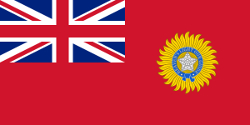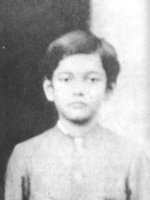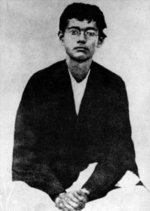
India
| Full Name | 30 Indian Empire | |
| Alliance | Allies - Minor Member Nation or Possession | |
| Possessing Power | United Kingdom | |
| Entry into WW2 | 3 Sep 1939 | |
| Population in 1939 | 378,000,000 | |
| Military Deaths in WW2 | 87,000 | |
| Civilian Deaths in WW2 | 1,500,000 |
Contributor: C. Peter Chen
ww2dbaseBritish control of India began in 1757, by the British East India Company, followed by the establishment of the Indian Empire (unofficially: British Raj; "Raj" was the Hindustani word for "rule") in 1858. Just before the start of the war, Aden and Burma were broken out of British India into separate colonies. The entire colony was divided administratively into 7 major provinces (Assam, Bengal, Bombay, Central Provinces and Berar, Madras, Punjab, and United Provinces), 5 minor provinces, and almost 600 autonomous Princely States. During the war, the Govenors-General of India were the Marquess of Linlithgow (Victor Hope, 1936-1943) and the Viscount of Wavell (Archibald Wavell, 1943-1947). After the war, the WW2-era Supreme Allied Commander of South East Asia Command Louis Mountbatten (Viscount of Mountbatten of Burma) assumed that role between 1947 and 1948.
ww2dbaseIndia declared war on Germany in Sep 1939. At this time, the British Indian Army numbered 205,000 men. Through active recruitment of volunteers, its size would grow to over 2,500,000 men by the end of the war, making it the largest all-volunteer force in history. This force fought at home in India, abroad in Malaya, Singapore, Egypt, Libya, Iraq, Syria-Lebanon, Persia, Somaliland, Abyssinia, Burma, Italy, among other places. Indian troops particularly made up a significant percentage of the Allied force in Burma and in Italy, fighting in famed battles such as the 1943 Battle of Monte Cassino and the 1945 Battle of Rangoon. 17 members of the British Indian Army had won the Victoria Cross, Britain's highest military honor, during WW2. Many British and American bases, depots, training grounds, and airfields were also established in India for the war effort. India also provided a strong financial and industrial base for the United Kingdom. Field Marshal Claude Auchinleck would later say that the United Kingdom "couldn't have come through both wars if they hadn't had the Indian Army", referring to both WW1 and WW2.
ww2dbaseTwo major political parties dominated the local political scene. The All-India Muslim League was generally pro-British, and coordinated closely with the British war effort. The larger Indian National Congress, led by Mohandas Gandhi and others, was anti-colonial, and refused to aid the war effort until the United Kingdom would grand India full independence. British police and military police were often seen in the suppression of Indian National Congress activities.
ww2dbaseA number of more radical members of the Indian National Congress broke from the party and sided with the Axis powers. Subhas Chandra Bose was perhaps the most prominent example. With Japanese help, Bose reorganized the Indian National Army. This force was consisted of Japanese-captured Indian prisoners of war who were persuaded to switch sides, Indian volunteers, Malayan volunteers, and Burmese volunteers. It numbered 43,000 at its largest. The Indian National Army fought in Burma and India. Bose was also the leader of the puppet nation of The Provisional Government of Free India (Urdu: Arzi Hukumat-e-Azad Hind), or Free India for short (Urdu: Azad Hind). Bose and other leaders of the puppet government was installed in Japanese-occupied Singapore, and the only territory it controlled was the Andaman and Nicobar Islands. Administration of the islands were nominal, however, as the islands were largely administered by Japanese Navy personnel. Smaller numbers of Indians, generally former prisoners of war, served under the German and Italian banners. In the German military, they were organized under a regiment named Free India Legion (German: Legion Freies Indien; officially designated by the German Army as 950th Infantry Regiment (Indian)), later renamed the Indian Volunteer Legion of the Waffen-SS (German: Indische Freiwilligen Legion der Waffen-SS). In the Italian military, they were organized in a battalion named Azad Hind Battalion or Free Indian Battalion (Italian: Battaglione Azad Hindoustan or Battaglione India libera).
ww2dbaseDuring the war, over 87,000 Indian servicemen were killed. This number included those from modern day Pakistan and Bangladesh. It also included ethnic Nepalese soldiers.
ww2dbaseAfter the war, the Indian Empire was partition into two sovereign nations, the Dominion of India and the Dominion of Pakistan. The large population migrations caused by the partition directly led violence that caused the death of between 250,000 and over 1,000,000 deaths. The Republic of India was declared in Jan 1950, and the Islamic Republic of Pakistan was declared in Mar 1956. In 1971, after a bloody civil war, the Provisional Government of Bangladesh was declared independent from Pakistan; it was renamed the People's Republic of Bangladesh in 1972.
ww2dbaseSource: Wikipedia
Last Major Update: Dec 2017
| People | ||
| Bose, Subhash Chandra | Singh, Umrao | |
| Events Taken Place in India | ||
| Burma Road and the Hump | 1 Jan 1938 - 10 Nov 1945 | |
| Fall of the Andaman and Nicobar Islands | 23 Mar 1942 | |
| Battle of Imphal-Kohima | 8 Mar 1944 - 3 Jul 1944 | |
| Vehicles | ||
| Indian Pattern Carrier | ||
| Facilities | ||
| Karachi Airfield | Air Base | |
| Ramgarh Training Center | Army Base | |
Weather
WW2-Era Weather Data for India
Photographs
 |  |  |  |
India in World War II Interactive Map
Please consider supporting us on Patreon. Even $1 per month will go a long way! Thank you. Please help us spread the word: Stay updated with WW2DB: |
Visitor Submitted Comments
All visitor submitted comments are opinions of those making the submissions and do not reflect views of WW2DB.

- » Wreck of Teruzuki Found (27 Jul 2025)
- » USS Orlean's Bow Found (22 Jul 2025)
- » The Emperor of Japan Planned to Honor WW2-era Japanese POWs in Mongolia (4 Jul 2025)
- » US State Lawmaker John Winter Caught Using Racial Slur "Jap" and Apologized (11 Jun 2025)
- » US Government Plans to Purge WW2 Information (17 Mar 2025)
- » See all news
- » 1,182 biographies
- » 337 events
- » 45,119 timeline entries
- » 1,249 ships
- » 350 aircraft models
- » 207 vehicle models
- » 376 weapon models
- » 123 historical documents
- » 261 facilities
- » 470 book reviews
- » 28,412 photos
- » 365 maps
Joachim von Ribbentrop, German Foreign Minister, Aug 1939
Please consider supporting us on Patreon. Even $1 a month will go a long way. Thank you!
Or, please support us by purchasing some WW2DB merchandise at TeeSpring, Thank you!
23 Feb 2018 08:02:49 AM
India is the best